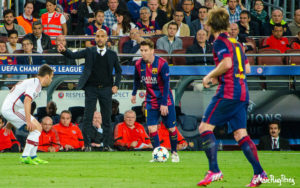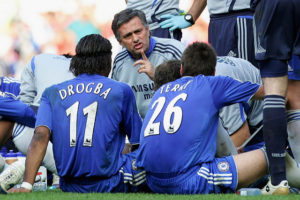Friday 21st October 2016.
When 6 year olds start playing football the coach’s main task is to stop them chasing the ball.
An aerial view of an under 7s match would resemble a strange dual coloured blob moving slowly around the field as twenty outfield players relentlessly seek control of the football.
Gradually, youthful exuberance and naivety give way to a calmer more measured approach as players are taught to respect the position they are playing in and the bunching around the ball subsides.
And for the most part a more and more structured game develops until young men are schooled in a myriad different formations and strategies from 4-4-2 to 3-5-2 and numerous variations in between.
Players come to know their roles and training reinforces the skills they’ll need to better carry out these roles. Defenders learn about positioning and tackling, midfielders about passing and creating space and forwards about finishing.
So far so predictable.
The Press
But what about the latest phenomenon to dominate from the pub discussion to the coach’s chalkboard? In the last few years the concept of the pressing game has reared its head as the latest and greatest solution to success in the modern game.
Very simply, the press is the name given to the idea that the team without the ball puts sharp, overwhelming pressure on the player in possession in an attempt to regain control quickly or at least to force the player to make a mistake.
The truth is, this idea is not so new.
Arguments abound as to the inventor of the pressing game or at least its first significant manifestation. Some credit Russian Viktor Maslov whose successful Dynamo Kiev of the 1960s played a high intensity style when out of possession. Football fans of my vintage will remember the scintillating Dutch team in the 1974 World Cup under coach Rinus Michels and around the turn of this century the eccentric Marcelo Bielsa has staked his claim with the Argentina national team as well as enjoying some subsequent success with Chile and Athletic Bilbao.

Perhaps the person responsible for bringing this style of play to current consciousness is Pep Guardiola, now at Manchester City.
As both player and coach, Guardiola is mainly associated with modern football’s past masters, Barcelona.
Barca’s playing style often referred to as tiki-taka employs the press as part of an overall strategy designed to dominate the opponent by retaining possession while probing their defence for goalscoring opportunities.
Confusion
Guardiola is single minded in his allegiance to this strategy and this is where confusion sometimes reigns given that to the viewer, Guardiola’s teams appear to play very differently from others assigned the label of pressing teams.
Barcelona and increasingly this season Manchester City are content to make sideways movements of the ball for long periods with the emphasis on controlling the ball and making their opponents chase. On the rare occasions they lose possession the press becomes evident as the nearest player to the ball, irrespective of whether he is a central striker or a full back breaks into a sprint and along with a teammate or two harries his opponent into a hurried and often unsuccessful action.
On the other hand, another proponent of the pressing game is Jurgen Klopp, currently Liverpool’s manager. Pressing is very obvious in Liverpool’s game but Klopp prefers a narrower shape to that of Guardiola. Many elements of regaining possession are the same for the two teams, for example the need for an event to trigger the press but the specifics vary greatly. While Guardiola instructs his players to trigger their press immediately upon losing possession, Klopp uses triggers such as an opponent receiving the ball while facing his own goal or an opposing player entering a designated area of the pitch.
Defensive Pressing
The press is not restricted to attacking teams pressuring the opposition right the way to their goalkeeper and taking a high defensive line like Manchester City or what is sometimes referred to as a mid press like that employed by Liverpool where it mostly takes place in the midfield areas. Even playing styles such as those described as more cautious like Jose Mourinho’s Chelsea made effective use of pressing.

Mourinho is known to be suspicious of pushing his defence too far forward. He also believes somewhat counter-intuitively that a team in possession is vulnerable given the anxiety players can feel about losing the ball and the time it takes the team to transition between attacking mode and a solid defensive shape should they do so.
But Mourinho is an advocate of a pressing game albeit in a deeper part of the field. Statistical evaluation has shown over the years that the most dangerous region of the pitch for a team without the ball is the central square just outside the defending team’s penalty area. This is the traditional domain of the attacking team’s number 10 or ‘the hole.’ Jose Mourinho’s teams defend this part of the pitch as if their lives depend upon it and try to prevent short passes from here into the penalty area or wide areas that often lead to goal scoring chances.
Not surprisingly, Mourinho utilises what has come to be called a low block.
Football is a fluid game so it would be too simplistic to try to pigeon-hole every team or coach’s style. But it’s clear that while what the Germans call Gegenpressing has attracted considerable traction in recent years as its most accomplished executioners continue to enjoy success with it, there are numerous versions of the basic idea.
Given the apparent scope for coaches to tweak the details like how high to press, what signals to use and which areas or players to focus on it sounds as though it’s certainly here to stay.
Here’s a thought to finish on. One tangent of the pressing game is referred to as the fake press. This is where a team on the receiving end of sustained pressing for a long period can be unsettled by the mere threat of pressure. If Jose Mourinho is right that a team is vulnerable as it transitions from defence to attack, how long will it be before teams playing against opponents who refuse to engage in real competition and are simply intent on parking the bus are lured into possession before being ambushed at their most vulnerable?
